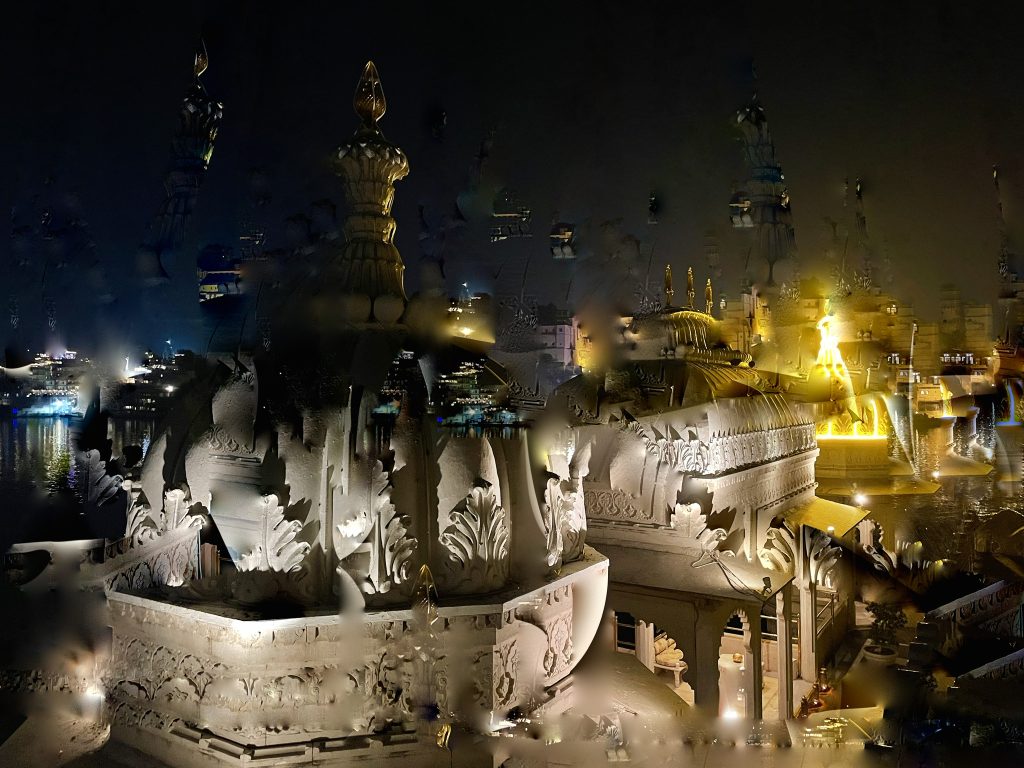Satarupa Bhattacharya

Photography has undergone several changes since the time of its inception when cameras were a luxury item to ‘memorialise’ family members and their achievements. Today, as we advance into a space with technological boons and banes, we’re still grappling with the ‘imaginary possession of the past that is unreal’. The dilemma in the (un)real dynamics of the photographs have now become even more terse and complex in the digital era as we try to disentangle the threads of image making and image production. In this article, the role of image is beyond memory and space. It has become a model to dissect and disseminate visuals that have become necessary to understand the visible culture of today. Thereby, it creates a special kind of meaning to look at the amalgamation of traditional photography with digital techniques. My study of the digital-arts stem from a reading of India’s Mumbai based artist Akshita Gandhi (b.1988) whose digital works engage with photography, art making, and the digital world.
In my eyes, the dilemma of the traditional and the more contemporary ways of looking at the digital space is to first enable the most fervent rhetoric of the modern day practices of image making where I work with the beauty of a given image in methods and then in semiotic or narrative terms. In the process, I look at Gandhi’s works to locate narration and image separately and simultaneously. The issue here is to resolve the difference between an image and its production, where Gandhi’s artworks are a case in point to explore both these areas.

Beauty Restored
Gandhi’s artworks are a distortion of the real world that surrounds her. It engages the semiotic inference in images, where every nuance is an insight into meanings. It begins with the picture which she takes with the help of a camera then she dissects the picture based on the available narrative with several digital programmes. This dissection is an act of restoration, where she renders aesthetic purposes to her image. The purpose is varied but it works with the idea that the image has meanings and, therefore, the meanings are emphasised. Here, the role of beauty is multiplied in essence as it only suggests the heightened power of imagination and creative practice. Also, the act of restoration is in the process of layering it with multiple digital enhancements that hold the hypothesis of the image while burying it too. The value of this image then heightens again, creating an ‘excess’ that the digital world is based on. This leads us to look at the role of digitisation closely.
Digitisation has often been associated with archiving and preservation, especially in recent times in museum studies and curatorial studies. The practice of digitisation also became mandatory for its convenience in storing information. Initially, this was limited to selective spaces but, with time, this became a focal practice. So much so that it is seen as an essential training in the Arts. Gandhi’s practice emerged from this focal point, where art intersected with archiving and preservation. Her images are an insight into the art of preservation, where she looks at architecture or structures as a site for reformulation of its already existing frame. Here, she returns to the structure with the intent of placing a special focus on its designs as a means to indulge its artistic language. She broadens this scope of engagement as she uses colours that are vibrant and contrasting to its original photograph.
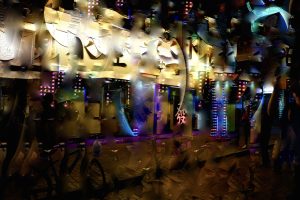
The lines that run over the photograph constitute an unoriginal world. It is that perfect moment when the real meets the unreal and the sense of both realities are at negotiations. Reminding us of the argument posed in the readings of the simulacra and simulation (Baudrillard 1994), this projection of Gandhi’s digital intervention on the traditional photograph leads to a pivotal moment in the digital world. This moment of real and unreal crisis resorts to its prime appearance, where the image begins to distort and reserve traces of its initial value. This is the value of sight against the light of imagination.
The labour that Gandhi invests is the process of decoding the traditional methods of art making, where the role of emptiness is prominent. The use of space provided as a platform for creative processes occupies an important rhetoric here as she transforms a photograph into a canvas of her digital markings. These markings, in turn, perform a special impact of emphasis. They are designs lingering in air and reinstating the real and unreal divide while coining an image of fanfare. The negative space is now burdened with the richness of imageries and, therefore, bereft of the emptiness that a canvas is supposed to initially present.
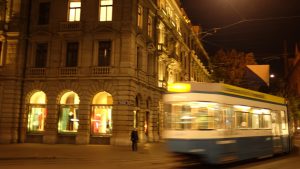
Image-making
After a photograph is taken and processed through the digital tools, Gandhi creates imagery laden with lines or shapes that are now important statements on nostalgia and image making. To begin with, the nostalgia evoked in Gandhi’s works are an intrinsic network of materials culminating in the image that we see. The initial photograph focuses on the structure of a given landscape: in most of her images, we see a reference to Mumbai and other historic cityscapes. The distortion that she brings to these structures is a symbolic longing to preserve the past. She returns to this past with the aid of technology and reinstates the technological influence that has become an obvious element of the cityspace. The pace of a city is reflective of the past of the city, where she returns to a sense of the past and not to the past in its truest essence.
Given the narratives on city-building, especially that of Mumbai, she brings the city to its immediate state, where the rushing events are mere consequences of city life. Her images also portray tall buildings from other cities, where windows are shown bursting with lights. The movement around these structures are portrayed as mere consequences of the space. This is largely an exploitation of the shadow effects to enhance the colour patterns staged around lit up areas (see Figure 2).
These images are a retrospective study of the city staged in action while halting it to a single moment. The artist begins to explore the singular impression through the various other timely interventions, such as Photoshop or other illustrative devices. The role of these applications is not just to enhance the image or aestheticize it, but to add more nuances of designs and patterns that bring more meanings to the existing ones. Here, the evaluation of the process may require an unsaid commitment from the artist in terms of time and efforts.
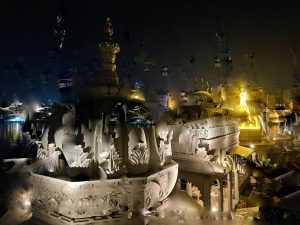
Gandhi’s works are a projection of the immediate surroundings, where most of her works explore the consequences of memories. Like in the case of the argument staged on post-memory, where the impacts of the Holocaust was negotiated with: her works explore the consequences of the city-making in her image-making systems. It is a systematic approach to the exploitation of the land, resources, and the aftermath of the several violence that goes into creating an active site for business. She returns to this city as an insider who reminds her viewers to engage with the richness of the lost lives to this city-making. The historical elements of her work are constantly decoding this violence that is embedded in structural forms. The use of bright colours records the spirit of this image which creates more imagined realities which the digital tools are capable of encoding.
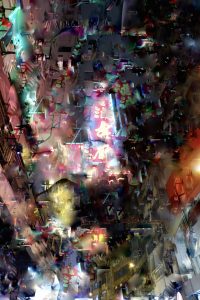
The artist creates a parallel world with the aid of the digital tools that helps her to recreate art from the traditional methods. The point being that traditional art forms have been elaborated with the aid of newer technical support systems only to achieve a reality of ‘excess’. This reality of heightened skills is Gandhi’s engagement, where she brings more introspective elements to the forefront. In doing so, she is able to create an alternate means to revisit and revise the past. Her images are an exposé of the world she cohabits and explores as a consequence to her times.
Therefore, the process of image-making and image-production are intertwined in her practice as a result of the various digitised treatments that are apparent in her works. Gandhi’s intervention is informed of spaces that are (un)real and subjective. She creates the distinct barrier of the image and nostalgia while she evokes both in order to engage with fantasy. One may say that such is the value of the digital world where one can look beyond meanings, matters, and salient features of representations. Here, her representation is also global where she is actively placing her own vernacular image for larger interactions.
References
Baudrillard, Jean (1994), Simulacra and Simulation, Michigan: The University of Michigan Press.
Sontag, Susan (1977), On Photography, London: Penguin Classic Books.

